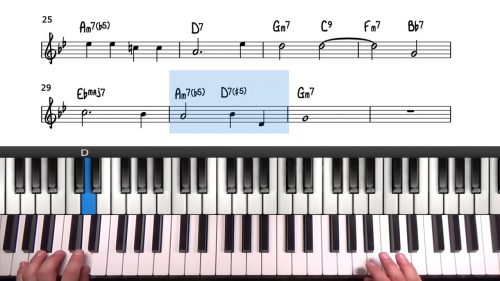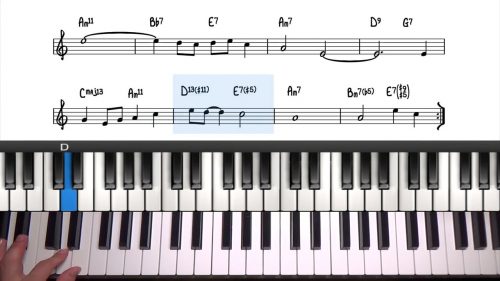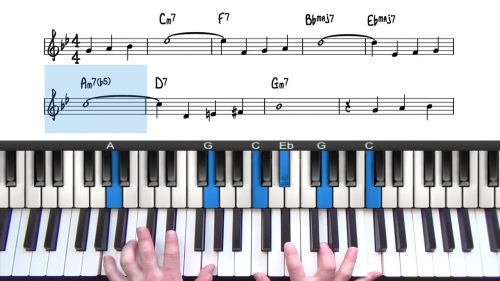Autumn Leaves Simple Walking Bass Line
In this lesson on Autumn Leaves bass lines, we will explore a simple way to approach the tune with a walking bass.
This is similar to how we approached the bass line for Summer Time Tutorial and we will mostly be using roots and 5ths to create the bass line.
The key to this approach is that we are only outlining the half beat. This means that the walking bass line will only be on beats 1 and beats 3.
This approach keeps things simple, and it will allow you to explore more melodic possibilities in your right hand.
Walking Bass Line With Root & 5th
The root and 5th can make an excellent bass line and it gives you a lot of freedom melodically to enhance the melody and add in improvised sections.
To get inspiration for melodic decoration and improvisation you need to listen to many different recordings of Autumn Leaves and take little bits from each.
You will hear every jazz musician phrases the melody differently. I particularly like to transcribe melody heads from trumpet and sax player because I like their approach patterns and how they target the chord tones.
Practice Tips
-
When practicing walking bass lines, or any medium to up tempo tune, you should play with the metronome on beats 2 & 4. This has a couple of benefits.
-
In jazz music, the strong beats are on beats 2 & 4, whereas in classical music the strong beats are beats 1 & 3. Playing with the metronome on 2 & 4 will improve your sense of time and also develop a stronger sense of swing.
-
In jazz bands, you will hear that the drummer hits the hi-hat on beats 2 and 4. If you practice with the metronome on beats 2 and 4, you will become very calibrated with this which will help you stay in time when you are playing in an ensemble setting.
-
Try to play as quietly as possible so that the metronome or iRealPro is louder than your playing. This will help you become calibrated with the metronome and your ability to feel the time, not just count it.







Thanks Hayden . This was a great improvisation lesson and I loved the swing and soul displayed in the tutorial .I’m eager for more. It was excellently presented.
Great stuff, thank you George.
I think you will love the upcoming study of blues… we really drill into some of the concepts covered here…. ‘chord tone soloing’ in particular and the important role that these tones play in an improvised line.
I’m very excited to launch this new section of the website and I think it will be a big hit with all students looking to develop their improvisation.
Cheers,
Hayden
Great lesson…I just finished working on Straight no Chaser. Really the 1st Jazz/Blues song I learned. I loved it and am learning a lot about improvisation. For Autumn Leaves, would you just recommend the same type of improvisation…using enclosures and aiming mainly for the 3rd, root, and 5th of the chords for this song?
Hi Jeff 👋
That’s awesome – glad to hear you are learning and improving!
The jazz blues form is used for many blues tunes, so once you have the voicings under your fingers, all you then need to learn is a new melody. It’s an important progression to know.
Yes I would absolutely recommend a similar approach. It’s slightly tricker than the jazz blue progression, because there are more chord types and a longer form.
In the Blues Improv course, I talk at length about the importance of transcription in learning to improvise.
I’d recommend first listening to lots of different recordings of this tune, and then trying to transcribe a few lines. Autumn Leaves is predominantly made up of 251s (both major and minor) which makes it a very useful tune to transcribe from, as this material can then be applied to 251s in other tunes.
From listening and transcribing, you will find a lot of the information we covered in the jazz blues course, such as aiming for primary chord tones, lines constructed entirely of chord tones, chromaticism, enclosures and other approach patterns. But by spending the time to transcribe lines aurally, and not just watch the video, you will retain this information 100x better and it will be with you for life.
In my opinion it is the most time-efficient and effective way to learn to improvise.
It’s hard to get started but check out the course on Transcription here: pianogroove.com/jazz-piano-lessons/how-to-transcribe-lines-solos/
Hope this helps Jeff :-)
Cheers,
Hayden
Hi. I purchased and downloaded iReal Pro ,but i dont find autumn leaves, actually i dpny see any songs , just exercises. Did i purchase the wrong thing? Did i need to add songs somehow?
Hi Steve,
Yes you have downloaded the correct application.
You must now download the “1400 Jazz Standards” Pack which is free once you have downloaded the iRealPro software.
Here is the link to do that: https://www.irealb.com/forums/showthread.php?12753-Jazz-1350-Standards
You must do this on the device where you have the iRealPro Software. For example, if you have the iRealPro on your iPad, you must click the above link on your iPad and then click the blue link in the thread where it says “Click On Link To Import”.
You will then see a notification, click OK, and the 1400 jazz standard songs will be imported for you.
Let me know if you have any further questions here.
Cheers,
Hayden
Pictures
Sorry i just figured out how to import a play list into ireal pro. It wasn’t mentioned here in this lesson but i found it in community under software and settings . Thanks